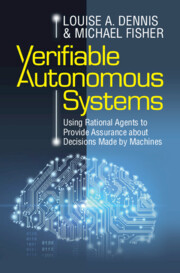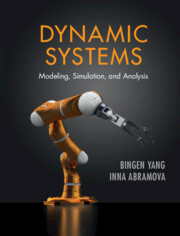Refine search
Actions for selected content:
2002 results in Engineering design, kinematics, and robotics
15 - The Future
- from Part IV - Concluding Remarks
-
- Book:
- Verifiable Autonomous Systems
- Published online:
- 25 May 2023
- Print publication:
- 08 June 2023, pp 244-245
-
- Chapter
- Export citation
4 - Formal Agent Verification
- from Part I - Foundations
-
- Book:
- Verifiable Autonomous Systems
- Published online:
- 25 May 2023
- Print publication:
- 08 June 2023, pp 42-57
-
- Chapter
- Export citation
3 - Agent Decision-Maker
- from Part I - Foundations
-
- Book:
- Verifiable Autonomous Systems
- Published online:
- 25 May 2023
- Print publication:
- 08 June 2023, pp 24-41
-
- Chapter
- Export citation
Part III - Extensions
-
- Book:
- Verifiable Autonomous Systems
- Published online:
- 25 May 2023
- Print publication:
- 08 June 2023, pp 175-176
-
- Chapter
- Export citation
5 - Verifying Autonomous Systems
- from Part I - Foundations
-
- Book:
- Verifiable Autonomous Systems
- Published online:
- 25 May 2023
- Print publication:
- 08 June 2023, pp 58-67
-
- Chapter
- Export citation
Acknowledgments
-
- Book:
- Verifiable Autonomous Systems
- Published online:
- 25 May 2023
- Print publication:
- 08 June 2023, pp xi-xii
-
- Chapter
- Export citation

Verifiable Autonomous Systems
- Using Rational Agents to Provide Assurance about Decisions Made by Machines
-
- Published online:
- 25 May 2023
- Print publication:
- 08 June 2023

Dynamic Systems
- Modeling, Simulation, and Analysis
-
- Published online:
- 28 April 2023
- Print publication:
- 24 November 2022
-
- Textbook
- Export citation
6 - Combined Systems and System Modeling Techniques
-
- Book:
- Dynamic Systems
- Published online:
- 28 April 2023
- Print publication:
- 24 November 2022, pp 396-501
-
- Chapter
- Export citation
Appendices
-
- Book:
- Dynamic Systems
- Published online:
- 28 April 2023
- Print publication:
- 24 November 2022, pp 758-777
-
- Chapter
- Export citation
1 - Introduction
-
- Book:
- Dynamic Systems
- Published online:
- 28 April 2023
- Print publication:
- 24 November 2022, pp 1-15
-
- Chapter
- Export citation
Index
-
- Book:
- Dynamic Systems
- Published online:
- 28 April 2023
- Print publication:
- 24 November 2022, pp 778-786
-
- Chapter
- Export citation
Appendix B - A Brief Introduction to MATLAB and Simulink
-
- Book:
- Dynamic Systems
- Published online:
- 28 April 2023
- Print publication:
- 24 November 2022, pp 761-770
-
- Chapter
- Export citation
7 - System Response Analysis
-
- Book:
- Dynamic Systems
- Published online:
- 28 April 2023
- Print publication:
- 24 November 2022, pp 502-588
-
- Chapter
- Export citation
3 - Mechanical Systems
-
- Book:
- Dynamic Systems
- Published online:
- 28 April 2023
- Print publication:
- 24 November 2022, pp 114-221
-
- Chapter
- Export citation
9 - Application Problems
-
- Book:
- Dynamic Systems
- Published online:
- 28 April 2023
- Print publication:
- 24 November 2022, pp 666-757
-
- Chapter
- Export citation
2 - Fundamentals of Mathematics
-
- Book:
- Dynamic Systems
- Published online:
- 28 April 2023
- Print publication:
- 24 November 2022, pp 16-113
-
- Chapter
- Export citation
Acknowledgments
-
- Book:
- Dynamic Systems
- Published online:
- 28 April 2023
- Print publication:
- 24 November 2022, pp xiii-xiv
-
- Chapter
- Export citation
5 - Thermal and Fluid Systems
-
- Book:
- Dynamic Systems
- Published online:
- 28 April 2023
- Print publication:
- 24 November 2022, pp 334-395
-
- Chapter
- Export citation
4 - Electrical Systems
-
- Book:
- Dynamic Systems
- Published online:
- 28 April 2023
- Print publication:
- 24 November 2022, pp 222-333
-
- Chapter
- Export citation
